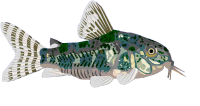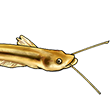Kaatz, IM, DJ Stewart, AN Rice & PS Lobel, 2010. Differences in pectoral fin spine morphology between vocal and silent clades of catfishes (Order Siluriformes): Ecomorphological implications. Current Zoology (in press).
The uncorrected proofs can be downloaded here.
Pectoral spines in vocal and silent catfishes
- Silurus
- Posts: 12461
- Joined: 31 Dec 2002, 11:35
- I've donated: $12.00!
- My articles: 55
- My images: 896
- My catfish: 1
- My cats species list: 90 (i:1, k:0)
- Spotted: 428
- Location 1: Singapore
- Location 2: Moderator Emeritus
- bekateen
- Posts: 9650
- Joined: 09 Sep 2014, 17:50
- I've donated: $40.00!
- My articles: 4
- My images: 143
- My cats species list: 146 (i:106, k:34)
- My aquaria list: 37 (i:14)
- My BLogs: 44 (i:154, p:2563)
- My Wishlist: 36
- Spotted: 184
- Location 1: USA, California, Stockton
- Location 2: USA, California, Stockton
- Contact:
Re: Pectoral spines in vocal and silent catfishes
The final paper above is available here: http://www.actazool.org/temp/%7BE93A901 ... BFD%7D.pdf
Also, here is recent work from the same lab:
Kaatz, IM, Stewart, DJ, & Lobel, PS. 2016. Vocal ridge morphology of callichthyid catfishes: variation within and similarities across species of the Corydoradinae. Integrative & Comparative Biology, 56(Supplement 1), pg. E310. (Abstract presented at the 2016 Annual Meeting of the Society for Integrative and Comparative Biology. Meeting Abstract P2.81.)
Also, here is recent work from the same lab:
Kaatz, IM, Stewart, DJ, & Lobel, PS. 2016. Vocal ridge morphology of callichthyid catfishes: variation within and similarities across species of the Corydoradinae. Integrative & Comparative Biology, 56(Supplement 1), pg. E310. (Abstract presented at the 2016 Annual Meeting of the Society for Integrative and Comparative Biology. Meeting Abstract P2.81.)
Kaatz et al. wrote:ABSTRACT
Callichthyid catfishes produce sounds by pectoral spine stridulation in agonism and reproduction. Vocal ridge shape can be acute and rounded within individuals for the subfamily Corydoradinae and is similar across species. Dorsal process ridge width and inter-ridge distance is similar across species. To determine whether species' mechanisms are convergent or have diverged we counted dorsal process ridge number for adult specimens (17 species, four genera) using scanning electron and dissecting microscopes. ridges ranged 34 to 45 (39 + 4 SD, n = 6 individuals). ridges ranged 19 to 44 (36 + 9, n = 6). ridges ranged 59 to 81 (68 + 8, n = 6). pooled species ridges ranged 38 to 76 (55 + 9, n = 70). Ridge number correlated with body size (SL) for Corydoras species pooled (r2 = 0.2293, p <0.00002). Total ridges per species for 14 Corydoras species (n = 4 to 9 individuals/species) positively correlated with body size (SL) for three species (r2 = 0.6834 to 0.9772, p<0.04 to 0.001). Specimen standard length was similar (4.0 cm + 0.8 SD, 2.3 - 7.5 cm, n = 89). The presence of vocal ridges in all specimens suggests that both sexes could vocalize. Correlation of ridge number with body size for some species and the similarity in adult size for many species in the Corydoradinae suggests that if species differ in vocal communication signals this would have to be accomplished by variation in vocal muscles, their origins or insertions and neural control.
Find me on YouTube & Facebook: http://youtube.com/user/Bekateen1; https://www.facebook.com/Bekateen
Buying caves from https://plecocaves.com? Plecocaves sponsor Bekateen's Fishroom. Use coupon code bekateen for 15% off your order. Also, for you Swifties: Https://youtu.be/ZUKdhXL3NCw









